

Site Search
Search within product
No. 746 Published 2022 (R04) .12
Click here for PDF version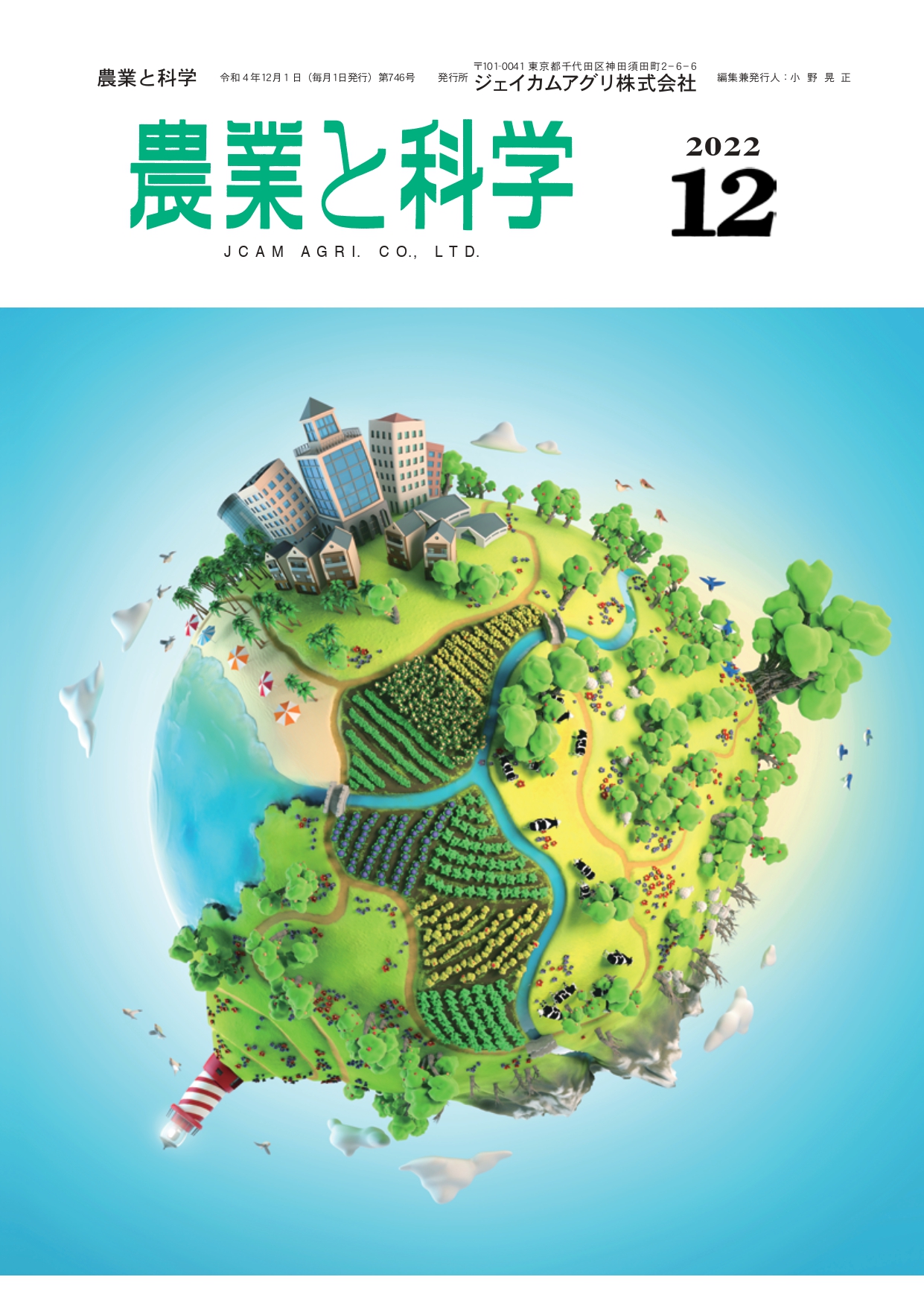
農業と科学 令和4年12月
本号の内容
§ Environmentally friendly spinach cultivation methods (Part 2)
Former Toyama Prefectural Agricultural Technology Center
松本 美枝子
§Early Cultivation of Rice 'Koshihikari' in
被膜崩壊性改良型緩効性肥料の施肥効果
Kochi Agricultural Technology Center
Crops and Horticulture Division, Paddy Crops
研究員 武田 俊也
No § Soil - Part 17
植物が水と養分を吸収するしくみ
-Absorb necessary substances and eliminate unnecessary ones.
Jcam Agri Co.
北海道支店 技術顧問
松中 照夫
§2022 General Table of Previous Editions of this Journal
Environmentally Friendly Spinach Cultivation Method (Part 2)
Former Toyama Prefectural Agricultural Technology Center
松本 美枝子
3. good use of solar thermal effects
Introduction.
Irrigation is important in the hot season cultivation of soft vegetables, but insufficient irrigation delays growth, while too much irrigation can lead to disease outbreaks caused by Pythium, Rhizoctonia, and Fusarium. Chemical treatment is considered necessary to stabilize production during high temperatures (summer), and soil disinfection using solar heat is also effective. We investigated a more effective method of disinfection by solar heat treatment.
Processing and research methods
After the footing was set up in the greenhouse, the greenhouse was thoroughly irrigated, the outer wall (membrane) was sealed, and the footing surface was also completely sealed with vinyl. Just before sowing, temperatures were measured at 5, 10, 15, and 20 cm below the soil surface using a thermometer with temperature sensors embedded at 5, 10, 15, and 20 cm below the soil surface, as well as at ambient and room temperatures. Thirty days after sowing, the types and numbers of weeds that had germinated were investigated.
Results and Discussion
Summer-sown spinach is susceptible to Rhizoctonia and Pythium until about 15 days after sowing (especially at the time of full emergence) and to Fusarium after 15 days, resulting in reduced yield. Rhizoctonia is killed after 12 hours of treatment at 45°C, Pythium after 24 hours, and Fusarium after 60 hours. This is the basis for the effectiveness of solar heat utilization. It should also be noted that the epidermal structure of spinach roots is relatively soft from germination to the 3 leaf leaflet stage, making them susceptible to soil-borne pathogens.
In the solar disinfection method, the greenhouse is sealed with vinyl and the ground surface is also covered with vinyl. To ensure a temperature of 45°C with a solar radiation of 5 MJ, an outside temperature of 27°C or higher at 5 cm below ground level, 30°C or higher at 10 cm below ground level, and 34°C or higher at 15 cm below ground level is required.
Therefore, solar heat treatment was conducted in test plot A, where Rhizoctonia and Pythium outbreaks were a problem. The treatment period was 10 days, and 45°C passed for 56 hours at 5 cm below the ground surface, 32 hours at 10 cm, and 7 hours at 15 cm.
In test plot B, where Fusarium was common, the disease and weeds were significantly suppressed in the no-tilled (12 cm) and tilled (12 cm) plots when seeding and fertilizer were applied to the surface layer, but the effect was lost when the plots were tilled. After 30 days of treatment in test plot B, the time elapsed at 45°C was 130 hours at 5 cm below the ground surface, 60 hours at 10 cm, and about 15 hours at 15 cm. In this case, the effect was observed in the first year (methyl bromide treatment in the previous year), but in the second year, wilting began around the greenhouse in the latter half of the growth period. In the same field, no wilting was observed in the chloropicrin-disinfected area.
In summary, the results described in the previous issue (Agriculture and Science, November issue) show that in a field where cattle manure compost is used continuously, it is not necessary to apply organic matter, soil improvement materials, or chemical fertilizers, but only nitrogen can be supplied by local application of LP30 (0.9 kg/10a) (tape-encapsulated fertilizers). The annual chemical soil disinfection can be replaced by solar disinfection once every two years.
On the other hand, in fields where dry chicken manure is used continuously, the application of organic matter, soil improvement materials, and chemical fertilizers is stopped, and humus is supplemented by 2 t/10a/year of cattle manure, and nitrogen is supplemented by local application of LP30 (2.7 kg/10a) (tape-enclosed fertilizer). In addition, as a soil disease control measure, annual disinfection in fields with low Fusarium densities and alternating chemical and solar disinfection in fields with high Fusarium densities will stabilize production.
This method increases the number of plantings because the application of organic matter and soil amendments can be reduced between cropping types. In addition, the fertilizer nitrogen utilization rate is improved, resulting in lower soil EC, among other benefits.
In the cultivation of spinach at high temperatures, diseases caused by Pythium, Rhizoctonia, and Fusarium are likely to occur, so soil disinfection using solar heat is effective. These treatments are effective at a depth of 5 cm below the soil surface, and the maximum depth is about 15 cm, so the effects cannot be maintained by tilling. In other words, the soil is mixed with fertilizers and soil improvement materials before each planting, so that about 17 cm of soil is stirred up by the rotary, and the disinfection effect is lost when the undisinfected soil and germinable weed seeds in the lower layer are lifted close to the surface.
Since Fusarium is killed by exposure to 45°C for 60 hours, the treatment period should be determined by checking the soil temperature. If the wilt is pronounced, the use of a chemical (chloropicrin) in combination with Fusarium fusarium should be considered.
In summer, even a one-week treatment at 45°C for 60 hours (5 cm below the ground) can be effective. Even before the start of the second crop, a two- to three-day treatment (a short period of solar heat treatment) with vinyl covering and a closed greenhouse after lightly leveling the surface of the rhizoctonia and pythium rhizoctonia and irrigating the rhizoctonia and pythium rhizoctonia with sufficient irrigation can not only kill rhizoctonia and pythium on the surface but also kill insects and eggs in the soil.
4. rational cultivation method of spinach
The results of previous tests have shown that organic matter is an excellent source of fertilizer components and material for improving soil physical properties. However, because there is a difference between the balance of fertilizer components required by crops and that of organic matter, the balance of fertilizer components accumulated in the soil is also disturbed. Therefore, it was considered that soil analysis should be conducted once every two to three years, and the deficient components should be applied with reference to the standard values shown in Table 1-3 in the previous issue, while the excess components should be applied sparingly if there is a disturbance in the balance of nutrients.
Nitrogen is absorbed by the crop in large quantities and is often washed away by rainfall, so it is necessary to apply a certain amount of nitrogen each crop. As a nitrogen fertilizer, coated urea (LP30), which shows leaching characteristics similar to those of spinach in nitrogen absorption, was sealed in water-soluble tape and embedded near the seeds (about 3 cm deep), thereby increasing the nitrogen utilization rate to about three times the conventional rate. However, although fertilization, plowing, and foot-breaking of spinach were neither hard work nor long hours, it was sometimes observed that half a month to one month elapsed before the next planting.
On the other hand, the use of solar heat has been shown to be effective in controlling major diseases of spinach, including fungicide temperature and time, and has also been shown to be effective in weed control.
Here, we decided to examine more effective and labor-saving fertilization and soil disinfection methods.
Introduction of no-till cultivation
In recent years, no-tillage cultivation of various crops has been reported to investigate their growth and changes in soil physical properties. Kaneda et al. reported that no-till cultivation of rice in heavy clay soil (reclaimed land at Hachiro Lagoon) resulted in better drainage than tillage cultivation because the subsoil structure was more developed. In addition, in order to maintain the effect of soil disinfection in highland Chinese cabbage and lettuce cultivation in Nagano Prefecture, Japan, a second crop of seedlings was planted without tillage by mulching the entire surface, and the seedlings were grown in a stable manner.
The yield of the plant was about 1.5 times higher than the previous year.
The above mentioned facts show that no-till cultivation is possible without losing the disinfection effect of soil tillage by encapsulating fertilizer (LP30) and seeds in seed tapes that match the nitrogen absorption pattern of spinach, and that delays in fertilization, tillage, and foot-building can be avoided, and as a result, the foot-building surface due to soil shrinkage in the summer can be securely recognized and the effects of soil disinfection and weed control can be recognized and sustained. As a result, cracks on the surface of the ridge caused by soil shrinkage in summer can be eliminated, and the effects of soil disinfection and weed control can be recognized reliably and sustained.
[Example of rational spinach cultivation
① 施設ホウレンソウのスタートは夏場(温度の高い時期)とし,あらかじめ土壌分析を行う。仕事量に応じて,播種時期を検討する(段播き方法を考慮する) 。
(2) Apply organic matter and fertilizers as necessary according to the results of soil analysis and tillage.
(iii) Establish a footing and irrigate well.
④ ハウスの外壁及び畦面を密閉し,15日程度太陽熱消毒を行う。地温は表層(5cm)が最も高く,殺菌効果も大きいが,深くなるほど効果は劣る(図3−1) 。
⑤ 耕起せずにテープ状の種子及び肥料をシーダーマシンで地下3cm程度に埋設する。地表面に近いほど,太陽熱消毒の効果が大きいので,不耕起土壌にシーダーマシンで種子と肥料を埋設する方法は極めて有効である。シードテープ法のテープには水溶性素材(ホセトン)と微生物分解素材(メッシュロン)とがあり,前者は水に浸けるとすぐに溶けるが,後者は溶けない。したがって,メッシュロンテープに種子とLP30を封入した場合,水に浸漬し吸水させた後,30℃程度に加温することにより催芽処理が可能である。
(6) During the growing period, check soil moisture (irrigation), pests and weeds, and take actions as necessary.
⑦ 収穫は葉長20㎝程度から開始する。収穫の能率を高め生育を均一にするため5cm刻みに種子を播種(封入)する。
〜〜〜〜〜〜〜〜〜 one work completed
⑧ 二作目,三作目,四作目の播種前に雑草が出ていたら軽く除草し,再び⑤,⑥,⑦の順で作業を行う。
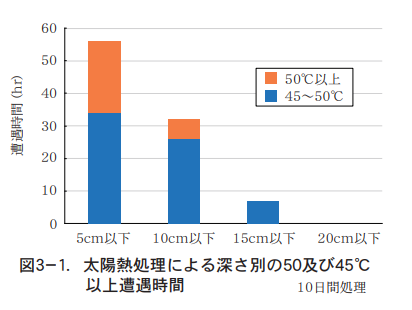
After one crop, three more crops were grown in no-tillage to investigate changes in soil hardness at the surface and below (in the root zone area).
The results showed that after one crop, the soil was harder than after tillage in both cases, and the degree of hardening was more pronounced in the first crop than in the first 10 cm below the surface. However, after two, three, and four crops, the soil did not become even harder, and there was no change in the tendency for the soil to be softer at 10 cm below the surface than the topsoil, and the growth of roots and above-ground parts was not inferior (Table 4-1). In addition, when cultivation was started in the spring, the surface layer of the soil was so compact that no cracks appeared on the surface of the next crop (summer crop).
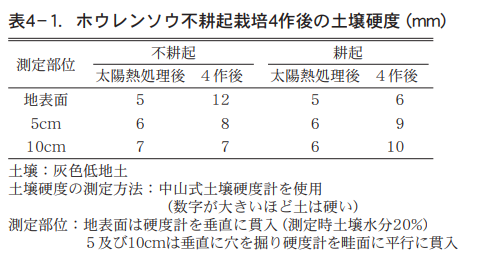
Introduction of no-till cultivation
Since fertilizer is applied before sowing, the accumulation of fertilizer components in the soil tends to increase and the balance of components is easily disturbed if the number of plantings of spinach in a facility is too frequent. Therefore, the soil should be checked once every two to three years, and if there is a deficiency, the component should be replaced, but if there is an excess and the component balance is disturbed, it should not be replaced.
The appropriate time to start anniversary cultivation is mid-July to mid-August, when solar disinfection is more likely to be effective.
Actual cultivation repeats steps (4), (5), and (6).
After the seed enclosed in seed tape and LP30 are buried in the soil, the seedlings are irrigated sufficiently and then harvested at 20 cm or more in height under normal management. For efficient harvesting, it is advisable to use a seeder machine, perform water absorption and germination treatment, sow efficiently, and harvest efficiently in order to have the planting density be appropriate and the germination rate and plant establishment rate as close to 100% as possible. Here, we propose to seal the seeds and LP30 in seed tape meshlon tape (which does not immediately dissolve in water) and then perform water absorption and germination treatment. This method not only accelerates germination and improves germination uniformity and shortens the growing period due to low temperature and dryness, but also saves labor for harvesting (Tables 4-2 and 4-3).
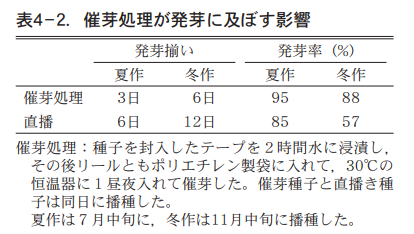
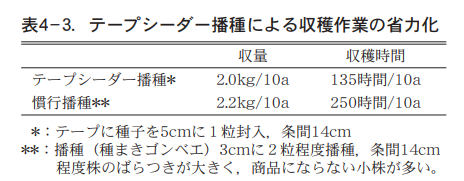
If the surface soil is hard due to no-tillage and cannot be uniformly buried in the soil with the tape seeder, a plow specially designed for this machine can be installed to improve the accuracy of the operation.
As described above, by encapsulating coated urea (LP30) and seeds suitable for nitrogen absorption by spinach in seed tape and burying them about 3 cm underground, the fertilizer component of organic matter (especially cattle manure) can be used efficiently, and the amount of nitrogen fertilizer applied can be significantly reduced. In addition, no-till cultivation provides sufficient soil disinfection and weed control by solar heat, which saves labor and shortens the work time.
The same effect as seed tape can be obtained by using a vacuum seeding machine.
References
●福井県,新潟県,富山県,石川県 地域重要新技術開発促進事業研究成果
生態系活用型農業における生産安定技術 福井県農業試験場 (1993)
●北海道立中央農業試験場 農芸化学部 土壌肥料科
短期太陽熱土壌消毒による露地ホウレンソウ立枯病・根腐病の軽減対策
土壌肥料科試験成績(1989)
●松本美枝子 施設ホウレンソウにおける窒素の合理的施肥方法
農業技術53(10)447−451(1998)
●宮元史登 生態系を活用した野菜の持続的安定生産技術の確立
太陽熱の効率的利用技術富山県農業技術センター 野菜試験成績書(1996)
●新潟県,富山県,石川県 地域重要新技術開発促進事業研究成果
北陸における野菜の持続的安定生産技術体系の確立 新潟農業総合研究所(1999)
●庄子貞夫監修 秋田県大潟村で実践する新しい水田農法
秋田県農業試験場大潟農場(2001)
●東京近郊野菜技術研究会編 軟弱野菜の新技術農耕と園芸 6月号別冊(1997)
Early Cultivated Rice 'Koshihikari' in
被膜崩壊性改良型緩効性肥料の施肥効果
Kochi Agricultural Technology Center
Crops and Horticulture Division, Paddy Crops
研究員 武田 俊也
Introduction
In paddy rice cultivation in Kochi Prefecture, slow-release fertilizers are widely used, in which fertilizer is coated with resin to control nitrogen leaching. However, this slow-release fertilizer has an environmental impact problem, because the residue of the film shells after leaching is likely to flow out of the paddy fields into rivers and the sea.
Recently, a new, easily collapsible film has been developed, and J-Coat, a slow-release fertilizer coated with this film, is expected to contribute to early collapse in the paddy field (Figure 1) and to prevent runoff from the paddy field by inhibiting surfacing during rice paddling. However, J-Coat tends to leach fertilizer nitrogen slightly faster than the conventional fertilizer, Emcoat 777, and there is concern that there may be a difference in fertilizer application effectiveness between these fertilizers.
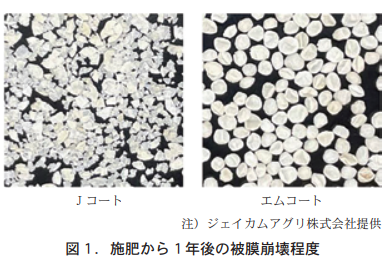
Therefore, we compared the growth, yield, and quality of 'Koshihikari' rice in 2020 and 2021 when New M-Coat 777 was applied and when M-Coat was replaced by J-Coat (Table 1, hereafter J-Coat composite), and investigated the effect of J-Coat composite on the growth, yield, and quality of 'Koshihikari' rice. The effect of J-Coat composite fertilizer application was investigated.
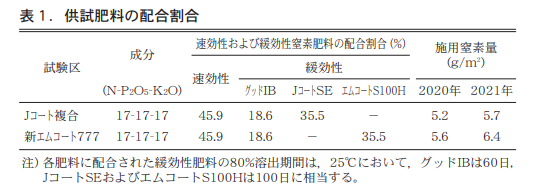
2. materials and methods
(1) Testing Method
試験は高知県農業技術センター(高知県南国市廿枝)の水田ほ場で行った。供試品種は‘コシヒカリ’とした。供試肥料はJコート複合と新エムコート777である(表1) 。 施肥方法は側条施肥とし,実際の窒素施用量は,2020年ではJコート複合5.2g/㎡,新エムコート777 5.6g/㎡,2021年ではJコート複合5.7g/㎡,新エムコート777 6.4 g/㎡であった(表1) 。両年とも4月7日に栽植密度18.5株/㎡で機械移植した。
(2) Survey Method
Weed height, number of stems, and leaf color (SPAD value) were measured from May 25 in 2020 and May 13 in 2021, approximately every 7 days until the maximum stage of flowering in both years. In 2020, 10 plants were planted in each plot for two replications, and in 2021, 20 plants were planted in each plot for two replications. In both years, we also investigated culm length, ear length, number of ears, and leaf color (SPAD values) at maturity, as well as milled brown rice weight, brown rice thousand grain weight, grain ratio (grain discriminator RGQI10A), and brown rice protein content (near infrared analyzer NIRFlex N-500) with 20 plants per plot and 3 replications.
Results and Discussion
(1) Year 2020
The grass height, number of stems, and leaf color (SPAD values) of both plots remained similar from post-transplant until June 8 (Fig. 2).
At maturity, although culm length was shorter in the J-coat composite compared to the new M-coat 777, there were no significant differences in ear length, number of ears, leaf color (SPAD value), polished brown rice weight, brown rice thousand grain weight, grain-to-grain ratio, and brown rice protein content due to fertilizer type (Table 2).
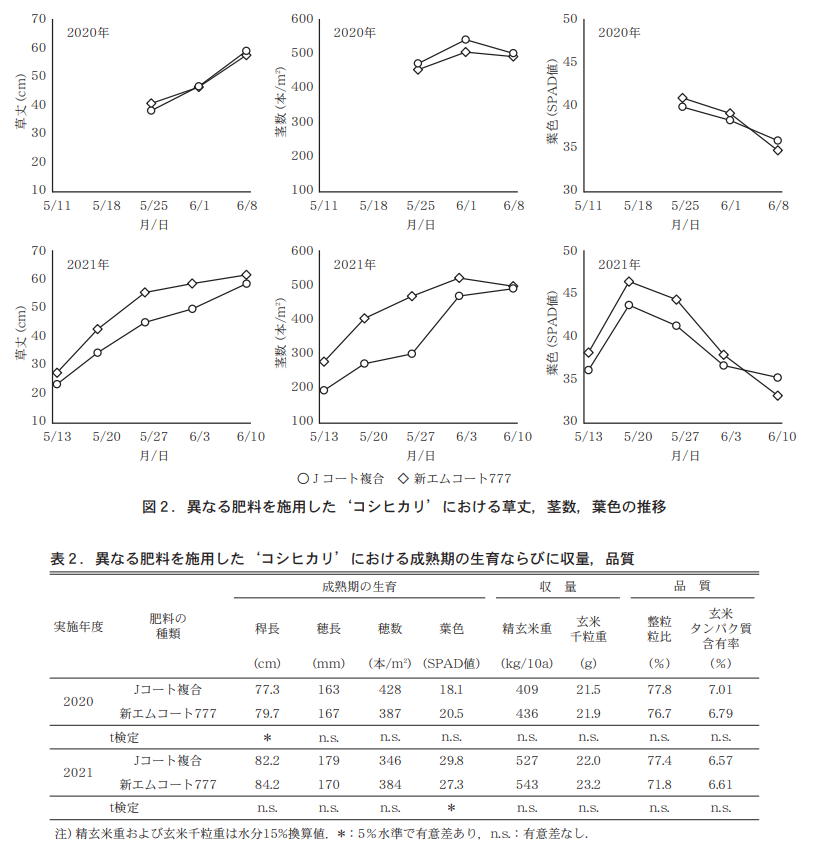
2) Year 2021
Compared to the new M-Coat 777, the J-Coat composite showed shorter grass height from transplanting to June 2, and fewer stems until May 26 (Fig. 2). Leaf color (SPAD value) was slightly lower from transplanting to June 2 (Fig. 2). At maturity, leaf color (SPAD value) was higher in the J-coat composite compared to the new M-coat 777, but there were no significant differences in culm length, ear length, number of ears, milled brown rice weight, brown rice thousand grain weight, grain-to-grain ratio, and brown rice protein content due to fertilizer type (Table 2).
These results indicate that in the early cultivation of 'Koshihikari', there were no differences in yield and quality between J-coat composite and new M-coat 777, although there were differences in plant height, number of stems, and leaf color (SPAD value) up to the maximum tillering stage and in culm length and leaf color (SPAD value) at maturity between the two cultivars. However, there were no differences in yield and quality. It is necessary to study the effect of J-Coat on fertilizer application in normal-season cultivation, which has different climatic conditions from early-season cultivation.
No Soil - Part 17
植物が水と養分を吸収するしくみ
-Absorb necessary substances and eliminate unnecessary ones.
Jcam Agri Co.
北海道支店 技術顧問
松中 照夫
Plants absorb water and nutrients through their roots. However, the mechanism is not as simple as taking in substances dissolved in soil water (soil solution) into the roots at the same time as the solution.
1. plant cells surrounded by cell membrane and cell wall
Plant cells are surrounded by a plasma membrane, which in turn is surrounded by a cell wall (Figure 1).
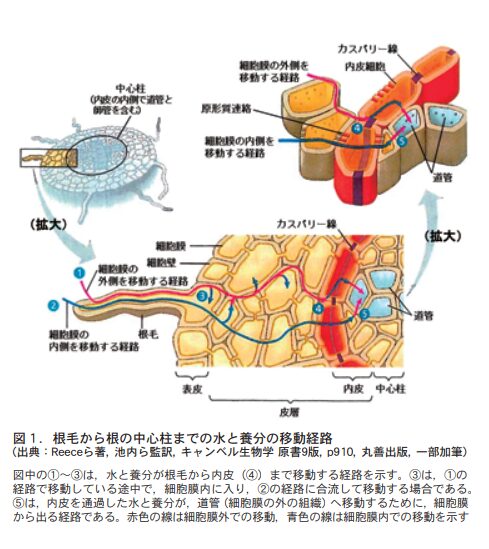
The cell wall is a colander-like mesh structure, through which water (in this case, pure H2O as a solvent for dissolving substances in the soil solution) as well as nutrient ions and many other substances dissolved in the soil solution can freely pass. ), as well as nutrient ions and many other substances dissolved in the soil solution. Substances that have passed through the cell wall ride the flow of water in the plant body created by leaf transpiration and reach the endodermis surrounding the central column of the root (Fig. 1, (4), where cells are connected one by one to form a ring). This is the migration path shown in Fig. 1 (i). Up to this point, the water and nutrient ions have not yet entered the inner cell membrane.
2. the last barrier to entry into the cell membrane - the caspary line
The cell wall of the endothelium is surrounded by a ribbon-like band of tissue called the cuspary line (Figure 1). Water and nutrient ions that have passed through the cell wall along the path shown in Fig. 1 (1) arrive at the cuspary line, where they are blocked and cannot move to the central column. This is because the cuspary line is made up of lignin, the main component of wood, and suberin, a type of lipid, and does not allow substances to pass through freely.
Apart from the pathway (1), there is another pathway where water and nutrient ions suddenly pass through the root hair cell membrane and move inside the cell (pathway (2) in Figure 1). In this case, the cell membrane that is first attempted to pass through determines whether it is allowed to enter the inside of the membrane. Only substances that are allowed to enter the membrane pass through the cell membrane. The next cell passes through the protoplasmic contact, which is a groove between cells. In this pathway, the endothelial cells can also pass through the endothelium and travel to the side of the central column ducts, since they have first entered the plasma membrane.
The problem is how it is allowed to enter the plasma membrane when it attempts to pass through the endothelial cell caspary line in pathway (1) and when it first passes through the plasma membrane in pathway (2), respectively.
3. cell membrane function and water absorption
-Osmotic pressure and transport proteins (aquaporins)
The cell membrane is composed of a bilayer of phospholipids consisting of hydrophilic and hydrophobic groups with hydrophobic groups next to each other (Figure 2). As shown in the figure, there are membrane-spanning proteins, which together constitute the cell membrane. These membrane-spanning proteins are called transport proteins, and play a major role in the transport of substances across the plasma membrane.
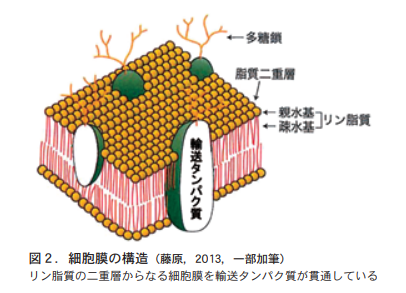
Since the plasma membrane holds a variety of intracellular substances, the concentration of substances is generally high inside the plasma membrane and low outside the membrane. If the cell membrane is a totally permeable membrane, such as the cell wall, which allows all substances to pass through, nutrient ions would normally be released from the inside of the cell, where the concentration is high, to the outside of the membrane, where the concentration is low, by diffusion through a concentration gradient. This makes the nutrient ions unavailable as nutrients. For this reason, the cell membrane is a semipermeable membrane that allows the solvent water to pass through, but not the solute nutrient ions or other substances. At this time, water enters and is absorbed by the highly concentrated inner side of the cell membrane to eliminate the difference in concentration between the inside and outside of the cell membrane. The pressure generated by this difference in concentration between the inside and outside of the semipermeable membrane is osmotic pressure.
However, osmotic pressure alone moves water too slowly to fully meet the water requirements of plants. The water transport proteins that compensate for this are aquaporins (also called water channels), which transport water at a very high rate. In many plant cells, aquaporins increase the rate of water transport by more than 10-fold (Hirasawa, 2016). It is mainly through the action of aquaporins that plants absorb water from soil solution.
4. How nutrients cross the cell membrane - active transport by transport proteins
Transport proteins are also responsible for the entry of nutrient ions dissolved in the soil solution into the plasma membrane. Nutrient ions, which are solutes in the soil solution, cannot pass through the cell membrane, which is a semipermeable membrane. Moreover, since there is a concentration gradient between the inside and outside of the plasma membrane, nutrient ions must enter the plasma membrane against the concentration gradient in order to be absorbed. This is made possible by the function of transport proteins that penetrate the plasma membrane.
These transport proteins do not freely transport any substance, but have their own specific transport partners. As already mentioned, water is transported by aquaporin, a water-specific transport protein. Ammonium ions, the nutrient ions of nitrogen, have a transport protein (ammonium ion transporter) that is responsible for their passage through the membrane. Plants are able to selectively take up only the nutrient ions they need from a soil solution containing various substances (selective absorption) because each transport protein has the property of transporting its own counterpart. At this time, there are also transport proteins that generate energy to transport nutrient ions from the outside to the inside of the membrane against the concentration gradient (active transport).
Thus, plants skillfully selectively absorb only water and nutrient ions from substances dissolved in the soil solution around their roots, eliminating unwanted substances.
5. the final step in nutrient absorption is transfer to the ducts
Absorbed water and nutrient ions do not remain in the root cells. The absorbed water and nutrient ions are transferred to the various parts of the plant body, such as the stem and leaves. This is done through ducts. Since ducts are pipes for transport, they are the outer tissues of the plasma membrane and consist mainly of cell walls.
Therefore, water and nutrient ions that enter the endothelial cell must again move out of the plasma membrane and into the ducts (Fig. 1, movement ⑤). The transport protein that performs this role is often not the same transport protein that was used to enter the plasma membrane, but another transport protein.
Thus, water and nutrient ions that reach the ducts move to the plant organs where they are needed, where they are used as nutrients and converted into substances that nourish the plant.
General Index of Previous Editions of this Journal in 2022
<January issue
§ Responsibility of fertilizer manufacturers to contribute to agriculture
ジェイカムアグリ株式会社 常務執行役員 勝呂 俊行
§ Sakai Farm built by our predecessors (No.3)
〜120年の歴史−成績書から振り返る
品種・肥料等の変遷〜
JA福井県 坂井農場
前農場長 長谷川 彰
No § Soil - No. 8
Conditions for Good Soil Chemical Properties - Part 3
適度に含まれる作物の養分
ジェイカムアグリ株式会社 北海道支店
技術顧問 松中 照夫
<February/March combined issue
§Experience high-yield technology using a combination of side-row fertilizer application and seedling box placement.
ジェイカムアグリ株式会社 東北支店
技術顧問 上野 正夫
No § Soil - No. 9
Conditions for Good Soil Chemical Properties - Part 4
土が養分を保持するしくみ
ジェイカムアグリ株式会社 北海道支店
技術顧問 松中 照夫
<April issue
§Smart Agriculture Linked Soil Preparation and Next Generation Base Fertilizer One Shot
Development of high-yield technology for staple rice through variable fertilization system
株式会社ファーム・フロンティア 取締役会長
山形大学農学部 客員教授 藤井 弘志
No § Soil - No. 10
Summary of Good Soil Conditions
−どんな土でも必ずよくなる−
ジェイカムアグリ株式会社 北海道支店
技術顧問 松中 照夫
<May issue
§Improvement of fertilizer efficiency and conservation in tea gardens
ための条施肥技術の確立
静岡県農林技術研究所
茶業研究センター 茶環境適応技術科
研究員 小野 嵩知
§Fertilizer with regulated fertilizer in two-row barley.
用いた全量基肥播種溝施肥法
大分県農林水産研究指導センター
農業研究部 水田農業グループ 清田 梨華
No § Soil - No.11
Compost emerged as a nutrient transfer material.
−養分の補給方法を考える−
ジェイカムアグリ株式会社 北海道支店
技術顧問 松中 照夫
<June issue
§ Nutrient water absorption and its transfer between day and night in tomatoes
元 岡山大学大学院 自然科学研究科 桝田 正治
No § Soil - No.12
Manure Effectiveness and Soil Conditions
−土の黒さが決め手−
ジェイカムアグリ株式会社 北海道支店
技術顧問 松中 照夫
<July issue
§Using fertilizer with regulated fertilizer
シクラメンの省力栽培技術
長野県野菜花き試験場 花き部 森野 林太郎
No § Soil - No.13
Types of Organic Substance Materials and Their Effects
−C/N比が要点−
ジェイカムアグリ株式会社 北海道支店
技術顧問 松中 照夫
.
§ Coated phosphorus nitrate and phosphorus nitrate in open-air summer/autumn green onion
リン酸質肥料のチェーンポット内施肥技術
地方独立行政法人 北海道立総合研究機構
農業研究本部 道南農業試験場
研究部 生産技術グループ
主任主査(栽培環境) 大橋 優二
§ In the Kamimashiki area
農協営農活動の変遷と私の出合
農事組合法人 かしま広域農場 工藤 健一
No § Soil - No. 14
Era of change in nutrient source from compost to chemical fertilizer
−その歴史的経緯−
ジェイカムアグリ株式会社 北海道支店
技術顧問 松中 照夫
<Oct.
§ Derived from coated fertilizers
マイクロプラスチックの生態リスクと排出量
農研機構農業環境研究部門 上級研究員 永井 孝志
§High in "Ra-mugi" wheat for Chinese noodles
子実タンパク質含有率を確保できる省力施肥法
福岡県飯塚農林事務所 飯塚普及指導センター 石丸 知道
No § Soil - No. 15
Wheat growth in a field where only chemical fertilizers are used
−堆肥だけの畑と比べる−
ジェイカムアグリ株式会社 北海道支店
技術顧問 松中 照夫
<Nov.
§ Environmentally friendly spinach cultivation methods (Part 1)
元 富山県農業技術センター 松本 美枝子
§ Otane carrot cultivation.
省力化・生産安定化に向けた技術開発
農研機構 東北農業研究センター
上級研究員 久保 堅司
No § Soil - Part 16
Comparing the Effects of Compost and Chemical Fertilizers
−共通点とちがいは何か−
ジェイカムアグリ株式会社 北海道支店
技術顧問 松中 照夫
<Dec.
§ Environmentally friendly spinach cultivation methods (Part 2)
元 富山県農業技術センター 松本 美枝子
§Early Cultivation of Rice 'Koshihikari' in
被膜崩壊性改良型緩効性肥料の施肥効果
高知県農業技術センター 作物園芸課
水田作物担当 研究員 武田 俊也
No § Soil - Part 17
How plants absorb water and nutrients
−必要な物質を吸収し,不要な物質は排除する−
ジェイカムアグリ株式会社 北海道支店
技術顧問 松中 照夫
§2022 General Table of Previous Editions of this Journal